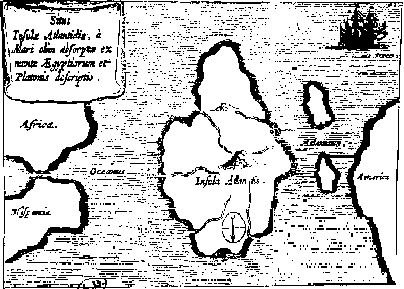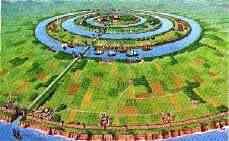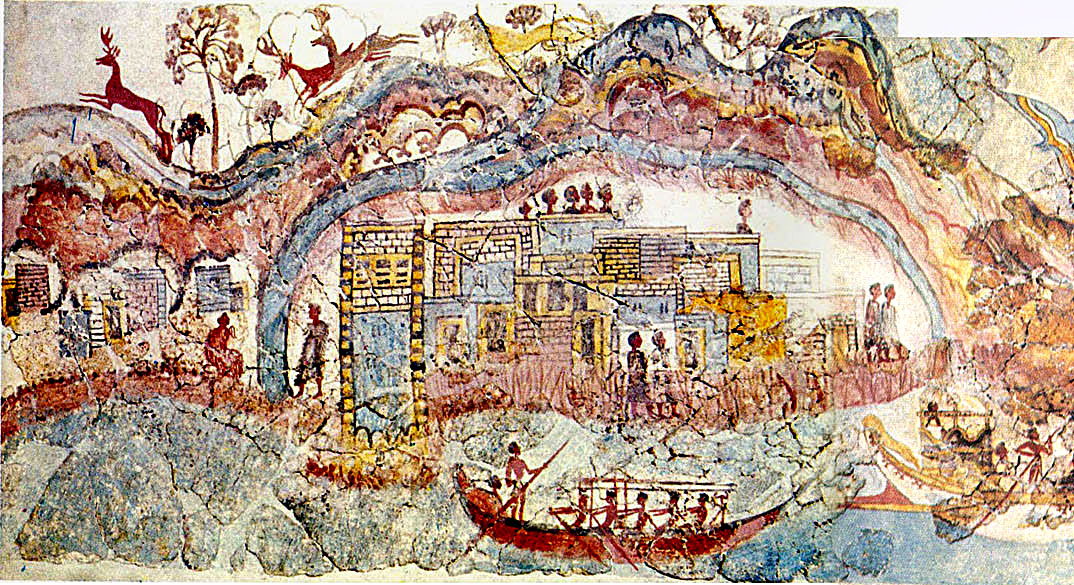Atlantis
January 1st, 2009 by MotU Overseer

Atlantis is one of the most known and debated legends in history, going back to the times of Plato and the ancient Greeks (The work in which Plato spoke of Atlantis was the Critias.). As the story goes, Atlantis was an island empire A painting of the ringed land of Atlantis from a distant view point. beyond the Pillars of Hercules in the domain of  Poseidon, the Greek god of the sea and earthquakes. Supposedly, Poseidon created the land for the protection of a mortal woman named Cleito, with whom he fell in love. He placed a dwelling on the top of a hill in the center of the island and then surrounded it with rings of both land and water. Eventually, Cleito gave birth to five sets of twin boys, among whom the land was divided, making the eldest of them, Atlas, for whom the land was named, the first ruler of Atlantis. Atlas was given rule over the central hill and the surrounding lands. A magnificent temple was constructed with a pinnacled roof so high that the clouds drifted about its spires and the rest being made out of red, black, and white marble and set with inlays of gold and precious stones so that it blazed gloriously in the sun of the Eden-like land on top of the central hill to honor Poseidon. It housed a golden statue of the great god himself riding in his chariot, which was drawn by winged horses, and attended by sea nymphs and dolphins.
Poseidon, the Greek god of the sea and earthquakes. Supposedly, Poseidon created the land for the protection of a mortal woman named Cleito, with whom he fell in love. He placed a dwelling on the top of a hill in the center of the island and then surrounded it with rings of both land and water. Eventually, Cleito gave birth to five sets of twin boys, among whom the land was divided, making the eldest of them, Atlas, for whom the land was named, the first ruler of Atlantis. Atlas was given rule over the central hill and the surrounding lands. A magnificent temple was constructed with a pinnacled roof so high that the clouds drifted about its spires and the rest being made out of red, black, and white marble and set with inlays of gold and precious stones so that it blazed gloriously in the sun of the Eden-like land on top of the central hill to honor Poseidon. It housed a golden statue of the great god himself riding in his chariot, which was drawn by winged horses, and attended by sea nymphs and dolphins.
As the legend continues, Atlantis builds up great cities on the rings of land and open up trading their knowledge and goods with other lands. They later carve out a huge central canal leading to the southern sea through the land rings so that trading ships could sail right up to the different docks and trading posts positioned on the various rings. The canal itself was three hundred feet wide and one hundred feet deep. Its length fifty stades, stades being the unit of measurement used by the Atlanteans. This means that the canal was approximately five and a half miles long. (For the conversion and measurements of various parts of Atlantis, view the end of the Atlantis page).

Later in the history of Atlantis, the leaders supposedly no longer liked to merely share their knowledge and goods with the rest of the world and believed that those who benefited from Atlantis should therefore become its subjects and pay tribute. To accomplish this, the Atlantean army began a conquest of the world, defeating civilization after civilization until they came to an extremely out-numbered army of Athenians who fought relentlessly to resist them, eventually leading to their retreat to their ships. It was then that the skies darkened and the sea churned causing the ships to sink to the bottom of the ocean and the whole of Atlantis to be swallowed up into the depths of the Atlantic. Some believed that Poseidon was angered by the Atlanteans for being defeated by the Athenians and so destroyed them, and others believe that the Atlanteans, in all their power and knowledge had discovered the secrets of the cosmos and unleashed them thinking they had control only to be destroyed.
Measurements
One Stade = 607 feet or 185 meters
One Stade = 0.11 miles
The Inner Area
The Inner Ring of water was one stade, or six hundred feet, across.
The Center Land was five stades, or three thousand feet, in diameter, which equals a half of a mile.
The ring of water and the central land were surrounded on both sides by a wall covered in orichalcum, a metal unknown to Plato that was mined in great quantities, it was second in value only to gold.
The Middle Area
The Middle Rings of water and land were each two stades, or twelve hundred feet, in width.
The rings were surrounded on both sides by a wall covered with tin.
The Outer Area
The Outer Ring and its internal land, which was closest to the sea, were both three stades, or eighteen hundred feet, in width.
The rings were surrounded on both sides by a wall covered in brass and contained a horse racing track.
The Outer Wall
Surrounding Atlantis was an outer wall that encircled the outer ring of land, which was fifty stades, or eleven miles, in diameter.
Atlantean Bridges
The land rings of Atlantis were connected to one another by a system of walled bridges with towers and gates on either end. Not only were they walled and towered, but also guarded at each end. Each of the bridges was one hundred feet wide, which equals one sixth of a stadia (stade).
The Atlantean Plain
On the outer land ring of Atlantis, where the canal connected to the sea, there was an elliptical plain three thousand stadia long and one thousand stadia wide, or three hundred and thirty miles long and one hundred and ten miles wide. This seaside plain was surrounded in the north by mountains. Also, this plain was encompassed on the remaining sides by a trench one hundred feet deep, one stade wide or six hundred and seven feet across, and ten thousand stades long or approximately eleven hundred miles.
The Second Plain
Apart from the massive plain on the final land ring around the central canal, there was a second plain residing just beyond the city itself. This field was three hundred and thirty miles long and one hundred and ten miles wide and was surrounded by a secondary canal for water collection from mountain streams and rivers.

 Poseidon, the Greek god of the sea and earthquakes. Supposedly, Poseidon created the land for the protection of a mortal woman named Cleito, with whom he fell in love. He placed a dwelling on the top of a hill in the center of the island and then surrounded it with rings of both land and water. Eventually, Cleito gave birth to five sets of twin boys, among whom the land was divided, making the eldest of them, Atlas, for whom the land was named, the first ruler of Atlantis. Atlas was given rule over the central hill and the surrounding lands. A magnificent temple was constructed with a pinnacled roof so high that the clouds drifted about its spires and the rest being made out of red, black, and white marble and set with inlays of gold and precious stones so that it blazed gloriously in the sun of the Eden-like land on top of the central hill to honor Poseidon. It housed a golden statue of the great god himself riding in his chariot, which was drawn by winged horses, and attended by sea nymphs and dolphins.
Poseidon, the Greek god of the sea and earthquakes. Supposedly, Poseidon created the land for the protection of a mortal woman named Cleito, with whom he fell in love. He placed a dwelling on the top of a hill in the center of the island and then surrounded it with rings of both land and water. Eventually, Cleito gave birth to five sets of twin boys, among whom the land was divided, making the eldest of them, Atlas, for whom the land was named, the first ruler of Atlantis. Atlas was given rule over the central hill and the surrounding lands. A magnificent temple was constructed with a pinnacled roof so high that the clouds drifted about its spires and the rest being made out of red, black, and white marble and set with inlays of gold and precious stones so that it blazed gloriously in the sun of the Eden-like land on top of the central hill to honor Poseidon. It housed a golden statue of the great god himself riding in his chariot, which was drawn by winged horses, and attended by sea nymphs and dolphins. 